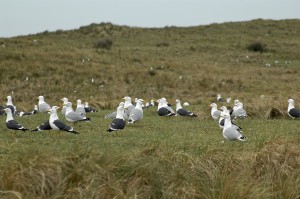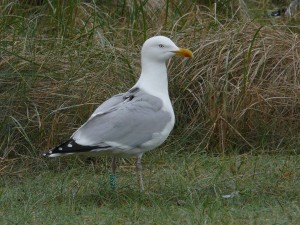
An important breeding colony for ongoing research is found on the Wadden Islands, Texel. (53°00’N, 04°43’E). Approximately 5000 pairs of Herring gulls breed in that area. The breeding ecology in this colony has been studied since 2006, and in 2013 we started tracking Herring gulls with UvA-BiTS GPS loggers. This study is running in parallel to a Lesser Black-backed gull tracking study in the same colony.
Current tracking work, together with the collection of prey items in the colony, will help us identify their primary foraging areas and resources during the breeding season, as well as their movement patterns throughout the non-breeding season. Tracking data from 2013 confirmed information derived from colour-ring resightings, that Herring gulls from Texel spend a large proportion of their time along wave breakers (breakwaters or groynes) along the coast of North Holland. On these breakwaters they feed predominantly on Blue Mussels Mytilus edulis. Current plans to reinforce the coastline by covering many of these breakwaters with sand will significantly change this foraging habitat.

The consequences of habitat change for Herring gulls breeding on Texel are unclear and a main focus of our current research. Colour-rings and tracking data show that individual birds utilising these (150 or so) breakwaters are often highly site-faithful: most birds use a small subset of the available breakwaters. The effect of destroying part of this foraging area will therefore be different for different individuals. Persistent dominance hierarchies, established at individual breakwaters, are the likely force steering the distribution of individual gulls rather than food supplies and differences in food quality between breakwaters. These and future tracking studies will focus on the changes imposed on the main foraging area, as well as on winter foraging areas that might explain why the overwinter survival of this species is compromised.
Contact persons, funders and participants
Kees Camphuysen kees.camphuysen@nioz.nl Koninklijk Nederlands Instituut voor Onderzoek der Zee / Royal Netherlands Institute for Sea Research (NIOZ)
Judy Shamoun-Baranes shamoun@uva.nl University of Amsterdam Institute for Biodiversity and Ecosystem Dynamics / Instituut voor Biodiversiteit en Ecosysteem Dynamica (IBED)

